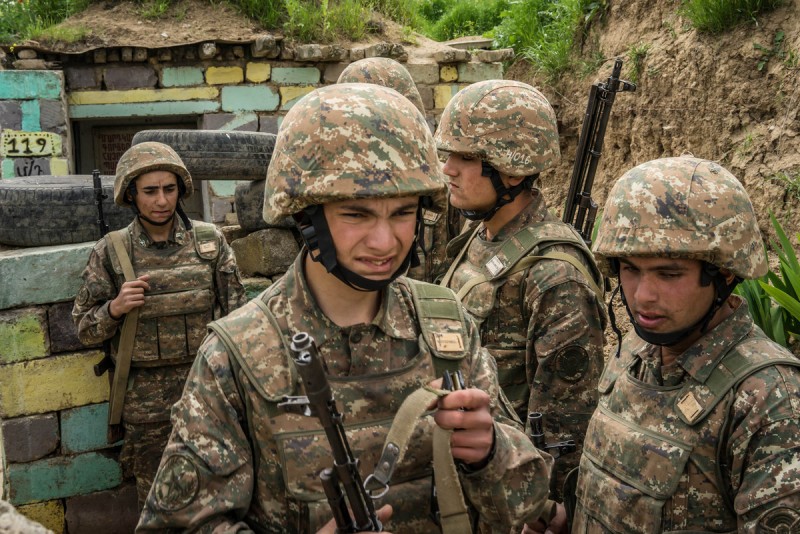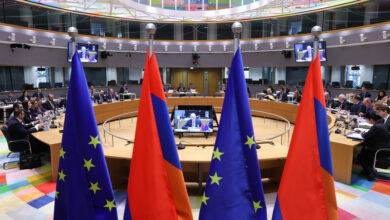Bloomberg: Karabakh flares, but full-scale war unlikely

From reinforced trenches reminiscent of World War One, Azeris and Armenians watch each other intently through binoculars. Separated by 300 meters of ground dotted with land mines, they’ve recently witnessed mounting casualties caused by ever-more powerful arsenals of weapons, Bloomberg writes.
“Their shooting is increasing,” said Simyon Sarayan, a 25-year-old front-line soldier from Nagorno-Karabakh. “We’re always on alert and ready to give a proper response.’’
While fighting between Armenia and Azerbaijan would bring more turmoil to the region – and potentially disrupt a new energy corridor between Central Asia and Europe – analysts say the risks of a full-blown war dragging in other powers are limited.
“A calculated escalation to a full-scale war is still unlikely at this point,” Laurence Broers, co-editor-in-chief of the Caucasus Survey journal, told Bloomberg. “The various constraints and risks are too great.” The international interests at stake in the region and “the exploitation of Caspian oil and gas militate against a fully-fledged military campaign.”
The agency reminds that the confrontation dates back to the dying days of the Soviet Union and adds that military spending in Azerbaijan increased 30-fold in the past decade and is planned at $4.8 billion in 2015, more than Armenia’s entire state budget.
That doesn’t deter Nagorno-Karabakh’s defense minister, Levon Mnatsakanyan, who says one of the first targets of any new war will be a BP-operated oil pipeline that’s less than 50 kilometers from the conflict zone and carries as much as 1.2 million barrels daily from Baku to Turkey’s Ceyhan.
“This is a very serious financial resource for Azerbaijan and we need to deprive them of these means,” he said in an interview in the capital, Stepanakert. “If we’d known the situation would be like this today, we’d never have signed that truce 20 years ago.’’
Azerbaijan has begun “a new stage of escalation of the situation with the use of heavy artillery,” and “violates fundamental international obligations” of resolving the conflict peacefully, Armenian President Serzh Sargsyan said at a conference in the capital, Yerevan, on Friday.
“The risk is that there will be a really bad incident and we’ll end up with a small war by miscalculation,’’ Tom de Waal, senior associate at Carnegie Europe, said by e-mail. While mediators “are trying to maintain the cease-fire” and keep talks going, “few believe in the chances of genuine conflict resolution.”
Nagorno-Karabakh President Bako Sahakyan equated weapons sales to Azerbaijan with similar supplies to Islamic State, now facing Russian air strikes in Syria. Even so, Armenians don’t want fighting to escalate and “we’ll do everything possible to secure our state,’’ he said in an interview last month.
Stretching out the status quo may be the Armenians’ best strategy. “Time is working for us,’’ Karen Mirzoyan, Nagorno-Karabakh’s foreign minister, said in an interview last month. “The more time passes and the more successful we are in strengthening our statehood, the closer we are to international recognition of our independence.’’
With Azerbaijan vowing Nagorno-Karabakh “will remain an inalienable part of’’ it, increased violence remains possible. Greater use of heavy weaponry has led to the “worst casualty rate since the 1994” truce as Azerbaijan seeks to challenge the outcome of the war, though “the conflict remains politically choreographed,” IHS Jane’s Intelligence Review reported on its website Tuesday.
In the Armenian trenches, senior-lieutenant Gegham Grigoryan points to evidence of that challenge left by shrapnel in the wall of a hut used by soldiers. “A mortar from a Turkish-made howitzer landed just behind here last night,” he said. “The types of weapons used here and their caliber has changed. They’re getting bigger.”








